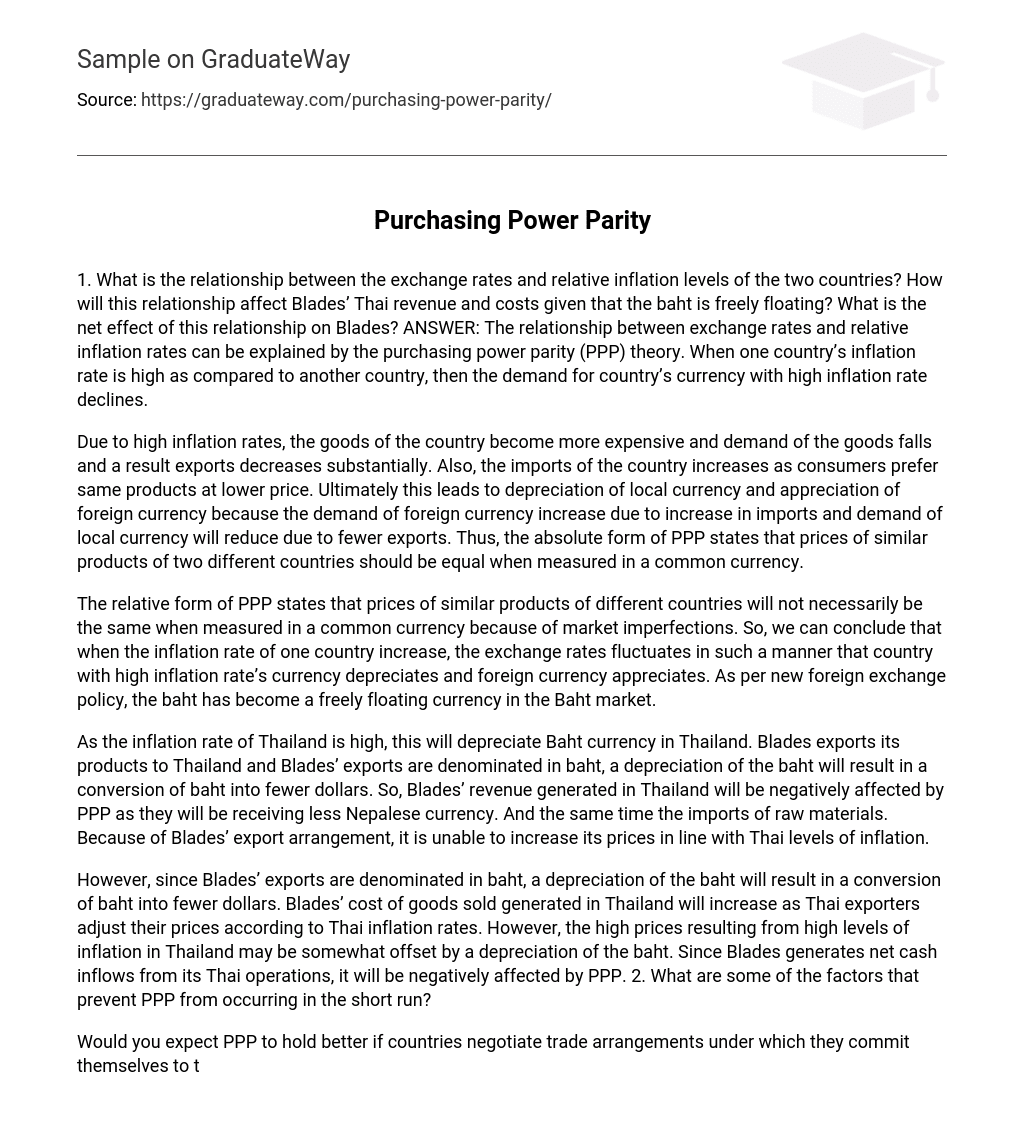1. The relationship between exchange rates and inflation levels of two countries can impact Blades’ Thai revenue and costs, as the baht is freely floating. This connection’s effect on Blades can be understood through the purchasing power parity (PPP) theory, which states that if one country has a higher inflation rate than another, there will be decreased demand for the currency of the high-inflation country.
If a country has high inflation rates, it results in higher prices for its goods. This leads to less demand and a significant decrease in exports. At the same time, imports increase as consumers opt for cheaper alternatives of the same products. As a result, the local currency depreciates while foreign currency appreciates due to increased imports and reduced demand for the local currency resulting from fewer exports. Hence, according to the absolute form of purchasing power parity (PPP), comparable products should have equal prices when measured using a common currency, regardless of the country.
Prices of similar products can vary in different countries when measured in a common currency due to market imperfections according to Purchasing Power Parity (PPP). As a result, the depreciation of a specific country’s currency and the appreciation of foreign currency occur when inflation rates increase. Currently, as part of the new foreign exchange policy, the baht is freely floating in the Baht market.
Blades, a company that exports products to Thailand and invoices in Baht, will be affected by the high inflation rate in Thailand. The depreciation of the Baht currency leads to reduced revenue for Blades when converting it into dollars. This reduction is caused by the negative impact of Purchasing Power Parity (PPP) on their generated revenue in Thailand, resulting in a decrease in Nepalese currency received by Blades. Furthermore, Blades’ export arrangement limits their ability to raise prices and keep up with inflation levels in Thailand. As a result, this situation also affects Blades’ import of raw materials.
However, a depreciation of the baht will cause a conversion of baht into fewer dollars, as Blades’ exports are denominated in baht. Also, the cost of goods sold generated in Thailand by Blades will increase as Thai exporters adjust their prices based on Thai inflation rates. However, the high prices resulting from the inflation in Thailand could be partly countered by a depreciation of the baht. Due to net cash inflows from its Thai operations, Blades will be negatively impacted by PPP. 2. What are some factors that hinder the short-term occurrence of PPP?
The question is whether PPP would be more effective if countries agree to trade arrangements that involve committing to a fixed number of goods over a specified time period. However, PPP may not hold because exchange rates are influenced by various factors including inflation differences, interest rates, national income levels, and government controls. Additionally, certain goods may not be impacted by PPP if there are no suitable substitutes available within the home country.
The relationship between two countries’ trade in goods may not be affected by inflation rate differences as suggested by PPP. Contracts between firms with different inflation rates committing to purchase a fixed number of goods for a specified period of time can disrupt PPP, particularly in the short term. This is due to the difficulty of terminating contractual agreements, resulting in a delayed impact of inflation rates on trade relationships and exchange rates. How can the high interest rates in Thailand be reconciled with the expected change in the baht-dollar exchange rate according to PPP? High real interest rates in a country may lead to increased demand for its currency, as foreign investors can earn higher returns in that country compared to domestic opportunities. This upward pressure on the currency is caused by the higher level of real interest rates.
The primary cause of the elevated nominal interest rates in Thailand is the expectation of substantial inflation in the country. As a result, based on the international Fisher effect (IFE), it is projected that the Thai baht’s value will decline sufficiently to counterbalance the difference in nominal interest rates between Thailand and the U.S. (4). In relation to Blades’ future plans in Thailand, should the company be worried about purchasing power parity (PPP)? The response is that while PPP might not be exact in the short term, it has been observed to be reasonably precise over a longer period.
Blades is currently engaged in a three-year export contract with Entertainment Products, Inc. as it considers the option of expanding into Thailand. The company needs to consider the Purchasing Power Parity (PPP) factor. In the long run, the considerable inflation in Thailand has the potential to reduce the value of the baht, which can effectively offset disparities in inflation rates. However, when the current contract ends in three years, Blades will have a chance to renegotiate it. It is important to recognize that PPP may have greater significance in some countries than others.
Blades is conducting an investigation into whether the purchasing power parity (PPP) will remain applicable in Thailand, following the implementation of a floating exchange rate for the Thai baht. One way to evaluate PPP between two countries is by examining the correlation between previous currency fluctuations and disparities in inflation. However, this approach cannot be used for Thailand because it previously had a fixed exchange rate with the dollar, making inflation rates inconsequential for the baht-dollar exchange rate.
One potential approach is to use regression analysis to examine the relevance of purchasing power parity (PPP) between the United States and a country that has similar inflation rates, economic characteristics, and trade relationships with the U.S. This regression analysis can then be used to evaluate how the difference in inflation between the U.S. and Thailand may impact the future exchange rate between the baht and dollar.





